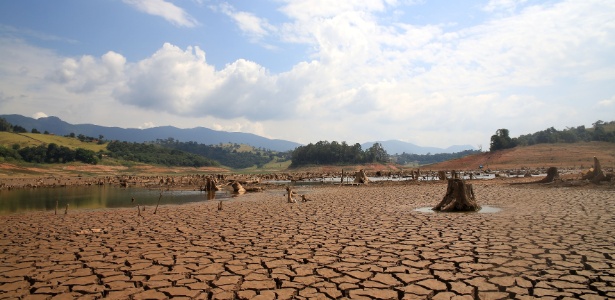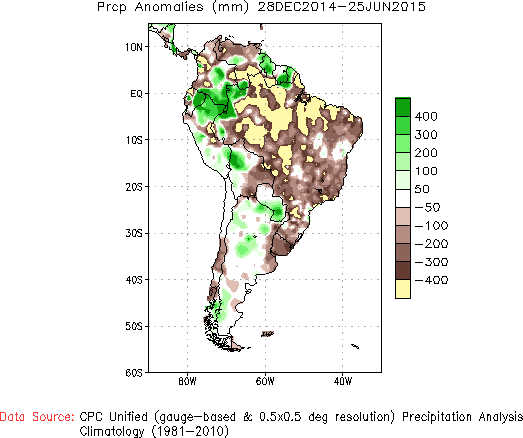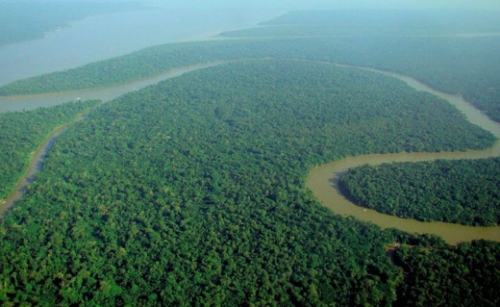It’s Not Just Sao Paulo — Much of South America and Caribbean Swelters Under Extreme Drought
26
June, 2015
In
Sao Paulo today, a Latin American megalopolis that is now home to 20
million people,public
water supplies are cut off for as long as three days at a time.
But despite this draconian rationing, the Cantareira Reservoir sits
at 9 percent below dead pool. A level so low that utility managers
had to install new pipes into the reservoir bottom to tap water
supply dregs. A controversial policy due to the fact that drawing
water from so low in the pool both results in fish kills and in much
more polluted water going into rivers (like
the foaming Tiete)
and the drinking and bathing supply.
(The
Cantareira Reservoir has been bone dry for more than a year and a
half now. Severe water rationing has managed to keep levels about
steady for the time being. Image source:UOL.)
At
least the dramatic cuts in water usage appear to have slowed to a
near halt further water declines from the key reservoir.
Levels have remained at around -9 percent below dead pool volume ever
since the rainy season ended two months ago. But Sao Paulo still has
at least four months of dry season ahead. And the weather for
Brazil’s largest city, for most of Brazil itself, for Colombia and
for the Caribbean remains exceptionally dry.
Drought
Extends Over Much of South America, Caribbean
Much
attention has been paid to the Sao Paulo drought. This is likely due
to the very dire water situation immediately threatening 20 million
people with severe water rationing, increased risk of waterborne
illness (see Dengue
Fever strikes Sao Paulo),
and spurring
migration to less water stressed regions.
But the quiet truth, less widely reported, is that a massive swath of
Latin America is also suffering major drought.
(South
American precipitation deficits and surpluses over the past six
months shows widespread, severe drought. Image source: NOAA’s
Climate Prediction Center.)
The
drought centers over the tree-depleted and human settlement invaded
Amazon Rainforest. There half year moisture deficits are in the range
of 400 millimeters or greater (16+ inches). A level of extraordinary
drought in a region that supplies critical moisture to the
surrounding states and nations. Years of clear cutting, slash and
burn agriculture, and ramping temperatures due to human-caused
climate change have taken a terrible toll on the Amazon. Now its
resiliency is compromised with drought a common-place occurrence even
as hundreds of wildfires burn away at the forest understory every
year.
The
warming climate (greenhouse emissions based), the water cycle
disrupting clear cutting, and the fires all take their toll,
resulting in a declining rainforest health and related moisture
levels. The worst years of all are El Nino years — when warming
Equatorial Pacific waters enhance drought potentials all throughout
the Amazon of Northern Brazil. And the 2015 El Nino is no exception,
with worsening drought conditions building at center mass over the
Amazon River Basin and its related rainforests.
Prevailing
and intensifying drought in the Amazon has far-flung impacts. The
region acts as a kind of atmospheric moisture reservoir — sending
out streams of flying rivers toward the North, South and East.
In this way a healthy Amazon rainforest pumps up the clouds over vast
regions, enabling rainfall from Colombia to the Caribbean and
throughout Brazil. But an ailing, warming, drought-sweltered and
clear-cut rainforest loses its ability to send out flying rivers.
Instead, it dries out at its heart.
(Often
visible from the air, the trees of the Amazon release vast clouds of
water vapor into the air. These ‘flying rivers’ are now drying up
as the Amazon is warmed by human climate change, burned by understory
fires, and clear cut by human development. Image source:Climate
News Network.)
For
some places in Colombia, this has meant residents suffering through
drought for more than three years. In La Guajira, some
residents are suffering loss of life due to lack of water and related
food stores.
The situation is complicated due to the fact that most of the water
from depleted aquifer supplies for the region now goes to industrial
uses like irrigation-fed international farms or the largest open pit
coal mine in the world. This leaves very little water left for
residents and what supplies remain are often brackish and polluteа.
In
the Caribbean, more than 1.5 million people are now affected by
drought with many also facing severe water rationing.
Water shortages, withering crops, dead cattle, and disruption to
tourism has impacted far-flung island nations from Puerto Rico to St
Lucia to Cuba to the Dominican Republic. In the Dominican Republic,
the situation is rapidly worsening with civil engineers stating that
many of the island nation’s towns have less than thirty days of
water left. Reports from other regions like Haiti are more spotty but
indications are that these are also heavily impacted (Haiti is
terribly deforested and, as a result, has very little resiliency to
any form of extreme weather).
With
El Nino still ramping up and with global temperatures likely to
continue to hit new record highs (due to the heating effect of
excessive fossil fuel emissions and CO2 levels hitting above 400
parts per million [above
480 CO2e]
for the first time in at least 3 million years) throughout 2015,
drought conditions for the Amazon, for Brazil, for Colombia and for
the Caribbean will likely continue to worsen for at least the next
six months. And to this point it is worth re-stating that crushing
drought conditions are not confined to Sao Paulo but instead range
from Uruguay through Brazil, Venezuala, Colombia and on into much of
the Caribbean Island Chain.
Links:
Hat
Tip to Greg
Hat
Tip to Colorado Bob






No comments:
Post a Comment
Note: only a member of this blog may post a comment.